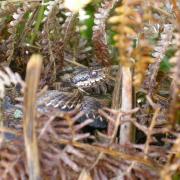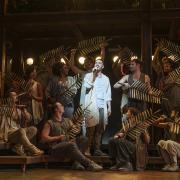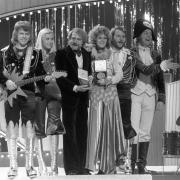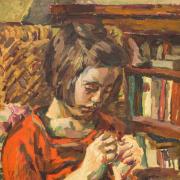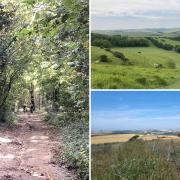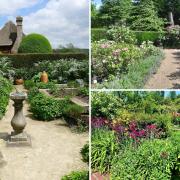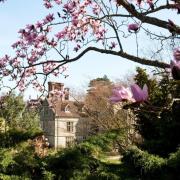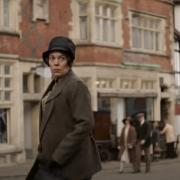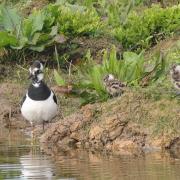Solution for ‘Caring hands’ piece by Tony Ward in the Sussex Life September issue
Where is it? Caring hands
Norman Manor, Tudor Mansion.
Hosts to Kings, a flattered Queen.
Fawkes the footman, The Accomplisht Cook,
a changing scene, but borrowed time,
.
accursed…
by fire and by water,
the end of the line.
.
New owners, new rooms, irons out the fire,
irons on the course, gold on the field,
clays in the traps, casts in the stream.
.
Stewards, custodians … caring hands.
Farms and forest,
bats and buzzards, hares and hawks,
cottages, café, a ruin restored,
together the parts, the greater whole.
.
Heritage in trust, no more at risk,
the hand of the artist,
Renaissance in the Tower,
quiet minds in the Chapel,
Returned to life … a home once more.
Solution – Cowdray House and Park, near Midhurst, West Sussex.
Explanation of embedded clues
The poem’s title ‘Caring hands’ connects to several concerns of the Cowdray Estate. These include care of the land, of the wildlife, of the ruins of the Tudor nobleman’s mansion, of the estate’s sporting heritage, of its day-visitors and of those taking advantage of the holiday cottages and luxury guest accommodation in the transformed Cowdray House. ‘Caring hands’ are also literally applied by the therapists using the facilities made available at Cowdray Hall and Chapel, healing both mind and body.
The estate has a noble history reaching back over more than seven centuries, to the time of King Edward I, who visited Coudreye with his son, the future Edward II in 1305. Coudreye was the name of the original Manor House on the site, built by Sir John Bohun in 1284. He chose that name as it was the Norman word for the nearby hazel thickets.
Some two hundred years later the house was acquired through marriage by Sir David Owen, uncle to King Henry VII. The old house was not big enough or imposing enough for his taste and so from 1520 he gradually demolishes Coudrey and begins building Cowdray. After nine years of living alongside his builders, the incomplete new house was sold to the Treasurer of Henry VIII’s household, Sir William Fitzwilliam. Sir William’s masons then took a few more years to complete the job. Apart from a few minor changes during the Georgian Period, and its semi-ruination by fire in 1793, it remains one of the most important surviving examples of a Tudor nobleman’s mansion.
As can be seen, both houses had Royal connections. “Hosts to Kings” refers to the visits of Edward I, Edward II, Henry VIII and Edward VI. The “flattered Queen” was Queen Elizabeth I, who stayed for a week in August 1591. Her host was the then owner, Sir Anthony Browne, 1st Viscount Montague. During the Queen’s Royal progress around her realm to noblemen’s houses, a certain amount of flattery was the order of the day. Verses and songs were often specially written to entertain the Queen during the evening entertainments (“masques”). This was almost certainly the case at Cowdray. Following a successful day’s hunting in which the Queen killed three deer and carried away ‘the honours of the day’, at the masque ‘nymphs in sweet arbours sang harmonious songs of the Queen’s glory’.
“Fawkes the footman” was of course Guy Fawkes of Gunpowder Plot fame, who had been briefly employed at Cowdray. The connection cast doubt upon the loyalty of the 2nd Viscount Montague who had stayed away from Parliament on 5th November 1605. He couldn’t have provided a suitable explanation as he was heavily fined and imprisoned in the Tower of London for forty weeks.
“The Accomplisht Cook” was Robert May, an early ‘celebrity chef’ who penned one of the first cookery books with that title and subtitled The Art and Mystery of Cookery. The massive hexagonal Tudor Kitchen Tower escaped the fire of 1793 and is open to visitors. This was cooking on an industrial scale. Some years before Robert May’s employ, on the morning after Queen Elizabeth I’s arrival for example, there was a ‘substantial reception breakfast of three oxen and a hundred and forty geese with et ceteras’. This occupied most of the morning. Unsurprisingly after this, no further special events had been arranged, it was a rest day. It was quite common in a large household to be cooking for possibly 200 people twice a day.
“Borrowed time” refers to the 255-year delay between, “accursed … by fire and by water”, the invocation of a curse on ‘the House of Cowdray’ and of its enactment. There are alternative accounts of how, when and where the curse was invoked, but all involve ‘Fire and Water’. Both are connected with the Dissolution of the Monasteries by Henry VIII.
In one account the curse is invoked by the Sub-Prioress of the local Easebourne Priory at the time of the eviction of the nuns and the seizure of the Priory and its lands. The ‘House of Cowdray’ became involved as it was Sir William Fitzwilliam, who was completing the building of Cowdray at the time who was the recipient of these holdings.
In another account the curse was invoked by a monk, outraged by the destruction of the Abbey Church at Battle Abbey. Henry VIII had granted the Abbey and its lands to Sir Anthony Browne, the next owner of Cowdray. The monk confronted Sir Anthony, who was holding his first great feast in the Abbot’s Hall at Battle, with the words, ‘by fire and by water, thy line shall come to an end and it shall perish out of this land’.
The ‘Fire’ came about in September 1783 and a few weeks later ‘Water’ ended the family line. The fire which destroyed the larger part of Cowdray was caused when a spark from a coal basket left burning by workmen set fire to wood-shavings and waste paper which had not been cleared from the floor. At the time, the young 8th Viscount was away on a pre-wedding holiday in Switzerland with his future brother-in-law. It would perhaps nowadays be thought of as his ‘stag-do’. Ignoring the advice of the locals they decided to ‘shoot the falls’ of the River Rhine at Laufenburg. Their boat overturned, both were drowned.
And so to the Victorian Age, “new owners, new rooms, irons out the fire”. In 1843 the estates were sold to the 6th Earl of Egremont, which his son then inherited in 1874. Like an earlier Cowdray owner, 350 years before, he decided to upgrade his accommodation adding “new rooms”. The Keeper’s Lodge was rebuilt to become the present Cowdray Park country house, serving him and subsequently his son, the 8th Earl of Egremont.
In 1908, there is then another “new owner”, Sir Weetman Dickinson Pearson, who in 1917 becomes Viscount Cowdray, the first of a new family line of ownership of the Cowdray Estate. The current and Fourth Viscount Cowdray, Michael Orlando Weetman Pearson, continues the family commitment to the Estate, which now embraces a wide variety of activities, properties and people. The estate is managed holistically, pulling together these many strands, “together the parts, the greater whole”.
The remaining verses identify some of these ‘parts of the whole’.
Firstly, the sporting activities. “Irons on the course” refers to the scenic 18-hole Golf Course founded in 1904 on the sandy soil of the higher ground. “Gold on the field” refers to the Cowdray Park Polo Club, host to the British Open Polo Championship for the Gold Cup, the current sponsors being Jaeger-LeCoultre. Cowdray is widely recognised as ‘the home of British Polo’, the sport having been played here for over 100 years. Bearing in mind Cowdray’s Royal connections, the term ‘The Sport of Kings’, which is applied to Polo as well as more commonly to horse racing, is particularly apt. Both H.R.H Prince Philip and H.R.H. Prince Charles have been Gold Cup competitors. “Clays in the traps” refers to one aspect of another sporting opportunity, clay pigeon shooting. There is also simulated game shooting. Finally, “casts in the stream” relates to fly fishing for wild brown trout on the River Rother which winds its way through the 7,500-hectare estate.
The penultimate verse considers the family’s role as “Stewards, custodians … caring hands.” The Cowdray Home Farms have all been accepted into Stewardship Schemes, recognising their commitment to sustainable agriculture and care for the environment. The Forestry Department manages the 36% of the estate which is woodland mainly comprising conifers, broadleaf forest, and Chestnut coppice. Timber production is chiefly through thinnings. An annual clearfell and replanting programme maintains the health of both the woods and its wildlife, “bats and buzzards, hares and hawks” being some of the creatures visible on the Estate-organised wildlife outings. The properties mentioned in the verse include holiday cottages for letting and a farm shop and café providing home-grown and organic produce. Some of the other facilities were touched upon in the opening paragraph.
Most importantly there is “a ruin restored”. The Cowdray ruins were the subject of a major ‘restoration, stabilisation, access and interpretation’ project in 2006/2007. Funding came from the Heritage Lottery Fund, English Heritage, the Cowdray Estate, individuals and the local community. The ongoing responsibility is now that of preservation and conservation under the aegis of the Cowdray Heritage Trust. The ruins are no longer the picture of romantic decay, as painted by JMW Turner and John Constable in the 19th Century, but are again a living part of the community. They are designated a Scheduled Ancient Monument and a Grade 1 listed building and are ”no more at risk”.
“Renaissance in the Tower” is the inspiration of Marina, Lady Cowdray. An artist and sculptor herself, she decided to find a ‘new and vibrant use’ for the octagonal room at the top of the Kitchen Tower. It has been transformed into a Renaissance Art Studio, the venue of art workshops with a Renaissance theme led by an artist-in-residence. The “quiet minds in the Chapel” reflect Lord and Lady Cowdray’s provision of the Cowdray Hall and Chapel for practitioners who share their interests in meditation, mind and body therapy and the exploration of the spiritual. The final line of the poem, “Returned to life … a home once more” echoes Lady Cowdrays satisfaction with the ‘complete upgrade’ which she steered in order to recreate ‘a family home full of heart and soul’. Engaging with its past, trust in its future … caring hands.
Acknowledgement of sources
• Lady Cowdray’s features, ‘Estate of the Art’, in Sussex Life magazine.
• www.cowdray.co.uk (The comprehensive Official website).
• en.wikipedia.org/wiki/Cowdray_House
• en.wikipedia.org/wiki/Cowdray_Park,_West_Sussex
• www.violetdesigns.co.uk/cowdray_castle_ruins.htm (history by Bridget Howard, Midhurst Society)
• www.marinacowdray.com (Lady Cowdray’s website, which includes images of her sculptures and painting).
• www.bigenealogy.com/familychests/house-of-cowdray.htm (British Isle Genealogy website article, ‘The Ill-Fated House of Cowdray’).
• Relevant websites found by searches for ‘Cowdray House and Park’, ‘Nichols progresses of Queen Elizabeth, Cowdray Park’, ‘The Pearson’s of Cowdray’.



